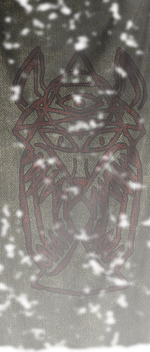Template:Character Infobox
Potema Septim, also known as the Wolf Queen, was a Queen of Solitude in Skyrim's hold of Haafingar during the Third Era. She was the daughter of Pelagius Septim II and Quintilla, and was a feared and most treacherous queen. Even after death, she would be feared and known as one of the most notable necromancers of her province. She is also one of the few historic figures to have been viewed by scholars as "unambiguously evil."[1]
The Last Dragonborn may fight her in 4E 201 as Potema's Remains, in which form she displays the ability of shouting.[2]
She is the primary antagonist of the quests "The Man Who Cried Wolf" and "The Wolf Queen Awakened."
Biography
Early life
Born to the Septim bloodline in 3E 67, Potema was presented to her grandfather, the Emperor Uriel Septim II; upon seeing the baby, he whispered, "She looks like a she-wolf about ready to pounce."[1]
Potema's childhood in the Imperial City was a difficult one. Her father, Prince Pelagius Septim II, and her mother Quintilla, showed little affection for their brood. Her eldest brother Antiochus, sixteen at Potema's birth, was already a womanizer, infamous in the empire for his drunken ways. Her younger brothers Cephorus and Magnus were born much later, leaving her the only child in the Imperial Court for many years.[1]
Courtship and marriage
By the age of 14, Potema was a famous beauty with many suitors, but she was married to cement relations with King Mantiarco of the Nordic Kingdom of Solitude. She entered the court as a mere pawn, but quickly became a queen. Despite the arranged nature of their marriage, the elderly King Mantiarco loved her, allowing her "all the power she wished".[1]
New Emperor and the birth of a son

The banner of Potema Septim
When Uriel Septim II died the following year, Potema's father Pelagius Septim was made Emperor. Facing a greatly depleted treasury, thanks to his father's poor management, Pelagius Septim dismissed the Elder Council, forcing them to buy back their positions. In 3E 97, after many miscarriages, the Queen of Solitude gave birth to a son, who she named Uriel after her grandfather. Mantiarco quickly made Uriel his heir, but the Queen had much larger ambitions for her child.[source?]
Two years later, Pelagius Septim died, many say poisoned by a vengeful former Council member, and his son, Potema's brother Antiochus, took the throne. At age forty-eight, it could be said that Antiochus' wild seeds had yet to be sown.[source?]
Mantiarco, King of Solitude, died the springtime after Pelagius Septim. Uriel ascended to the throne, ruling jointly with his mother. Doubtless, Uriel had the right and would have preferred to rule alone, but Potema convinced him that his position was only temporary. He would have the Empire, not merely the kingdom. In Castle Solitude, she entertained dozens of diplomats from other kingdoms of Skyrim, sowing seeds of discontent. Her guest list over the years expanded to include kings and queens of High Rock and Morrowind as well.[source?]
Antiochus' rule
For thirteen years, Antiochus ruled Tamriel, and proved an able leader despite his moral laxity. Both Potema and her son Uriel were visiting the Imperial Court in 3E 112 when Antiochus died, and Potema immediately challenged the rule of his daughter and heir, Kintyra II. Despite Potema's brilliant speech, the Elder Council allowed Kintyra to assume the throne as the Empress Kintyra II. Potema and Uriel angrily returned to Skyrim and began assembling the rebellion.[source?]
War of the Red Diamond
The details of the War of the Red Diamond are included in other pages: we need not recount the Empress Kintyra's capture and execution in High Rock in the year 3E 114, nor the ascension of Potema's son, Uriel Septim III, seven years later. Her surviving brothers, Cephorus and Magnus, fought the Emperor and his mother for years, tearing the Empire apart in a civil war.[source?]
Battle of Ichidag
When Uriel III fought his uncle Cephorus in Hammerfell at the Battle of Ichidag in 3E 127, Potema was fighting her other brother, Uriel's uncle Magnus, in Skyrim at the Battle of Falconstar. She received word of her son's defeat and capture just as she was preparing to mount an attack on Magnus's weakest flank. The sixty-one year old Wolf Queen flew into a rage and led the assault herself. It was a success, and Magnus and his army fled. In the midst of the victory celebration, Potema heard the news that her son the Emperor had been killed by an angry mob before he had even made it for trial in the Imperial City. He had been burned to death in his carriage.[source?]
When Cephorus was proclaimed Emperor, Potema's fury was terrible to behold. She summoned Daedra to fight for her, had her necromancers resurrect her fallen enemies as undead warriors, and mounted attack after attack on the forces of Emperor Cephorus I. Her allies began leaving her as her madness grew, and her only companions were the zombies and skeletons she had amassed over the years. The Kingdom of Solitude became a land of death. Stories of the ancient Wolf Queen being waited on by skeletal chambermaids and holding war plans with vampiric generals terrified her subjects.[source?]
Death
Potema died after a month long siege on her castle in the year 3E 137 at the age of 70. While she lived, she had been the Wolf Queen of Solitude, Daughter of the Emperor Pelagius Septim, Wife of King Mantiarco, Mother of Emperor Uriel III, and Sister of the Emperors Antiochus and Cephorus. Three years after her death, Cephorus died, and his and Potema's brother Magnus took the throne.[source?]
Return in the Fourth Era

Potema unleashes her fury.
Falk Firebeard, the steward of Jarl Elisif the Fair, sent the Dragonborn to investigate Wolfskull Cave near Solitude. Investigating the deepest reaches of the cave, the Dragonborn discovered a cult of Necromancers, attempting to summon Potema and bind her soul for their own purposes. They were believed to be unsuccessful, until Firebeard sent the Dragonborn to retrieve Potema's remains to prevent any such dark ambitions from being actuated again. Styrr, a priest at the Temple of the Divines, led the Dragonborn to Potema's catacombs below the temple, where her skull sat.

When the Dragonborn located the remains, it was discovered that although necromancers were stopped, Potema's spirit was summoned successfully and she was able to exist as a hostile specter, a ghostly phantom of her former self. Returning the skull to Styrr after defeating the Wolf Queen, the Dragonborn learned that Potema dabbled in necromancy while still alive, explaining why she was able to escape and stay as a ghost with free will after the ritual of the cultists failed. The priest also mentioned that had Potema been successfully resurrected, she would have the most legitimate claim to the Cyrodilic throne, which would have effectively ended the Mede Dynasty and revived the Septim Dynasty.
Quests
Gallery
Trivia
- Potema is responsible for the trademark insanity of Pelagius the Mad, through the use of her enchanted necklace that contained the soul of a mighty werewolf slain and soul-bound by her parents. Originally, this necklace allowed Potema to charm anyone she saw fit, but in her last act of defiance against the Emperor Cephorus, she changed the enchantment to one that would erode the mind of its wearer.[source?]
- In The Elder Scrolls V: Skyrim, a soul in the Soul Cairn says "All I said to Potema was I thought she looked a little portly in that gown. How was I supposed to know?", implying that Potema had him killed for unintentionally insulting the pregnant queen.
- Rumors surfaced in late 2012 of a trademark made by Bethesda Game Studios in partnership with several TV Publishers and Developers, this trademark was "The Wolf Queen." Much information has been removed from the internet and was never proven to be true.[citation needed]
Appearances
- The Elder Scrolls III: Morrowind (mentioned only)
- The Elder Scrolls IV: Oblivion (mentioned only)
- The Elder Scrolls V: Skyrim
Sources
- The Wolf Queen, Book I
- The Wolf Queen, Book II
- The Wolf Queen, Book III
- The Wolf Queen, Book IV
- The Wolf Queen, Book V
- The Wolf Queen, Book VI
- The Wolf Queen, Book VII
- The Wolf Queen, Book VIII
References
- ↑ 1.0 1.1 1.2 1.3 Biography of the Wolf Queen
- ↑ Events of The Elder Scrolls V: Skyrim


